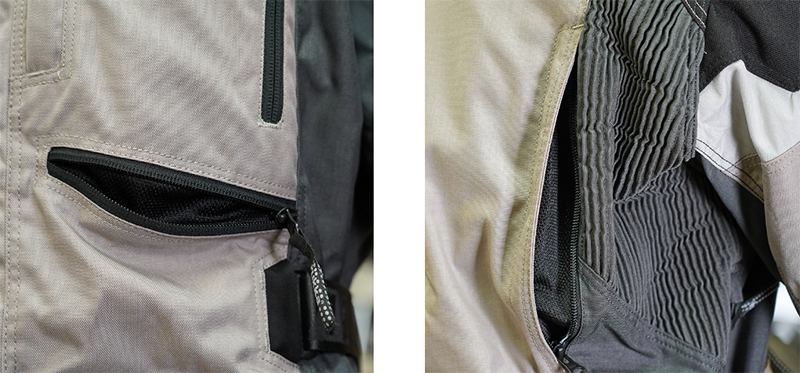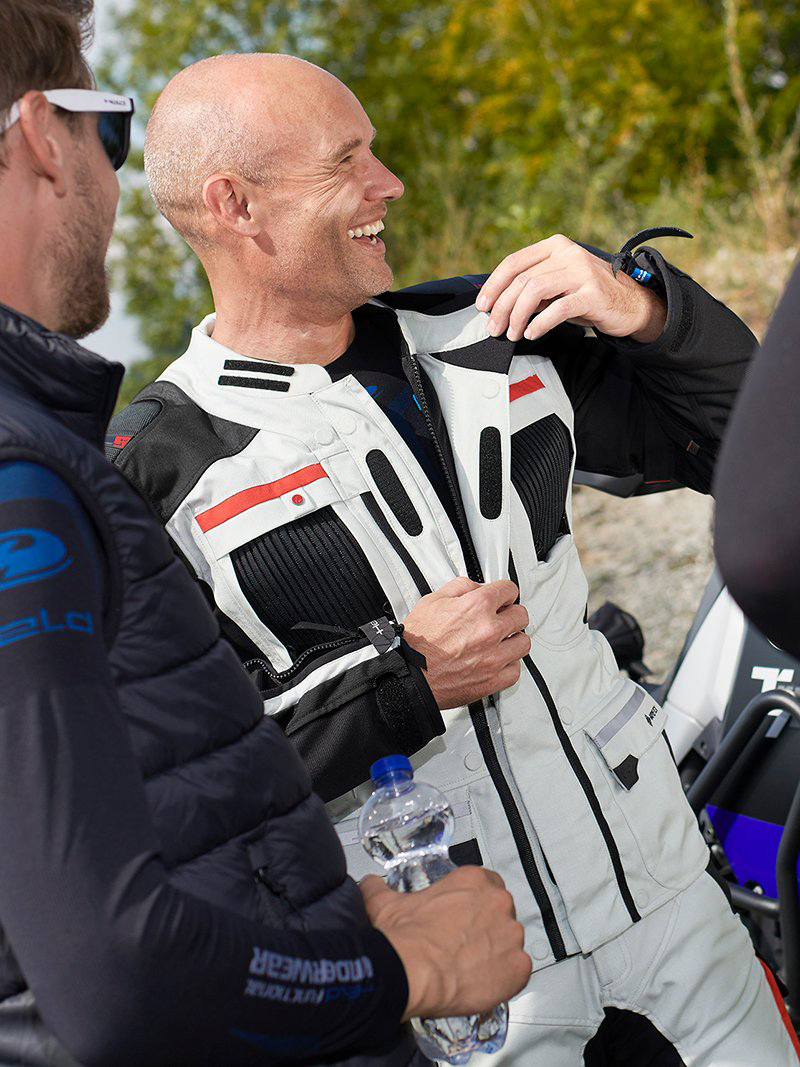Rukka Trek-R jacket review
Published on: 07 March 2024
Maybe, at times, we here at Motolegends can be a bit black and white about things; a bit purist. Perhaps it's our desire to cut through all the nonsense, to cut out all the noise, and to help people understand what kind of gear they do really need, and the gear they don't really need. And so we do sometimes get aerated when people bang on about adventure suits, as though it's a type of suit in its own right.
Now, an adventure bike really is the Swiss Army knife of motorcycles. You can do pretty much anything on a modern, adventure bike, although even BMW themselves acknowledge that 99% of GS owners will never stray from metalled surfaces.
The problem is that the adventure bike has become a bit of a fashion statement. Even though very few people will go off-road on an adventure bike, everybody wants knobbly tyres, extra spotlights, aluminium panniers, boots with clips; and most importantly a helmet with a peak; presumably for those evenings where the sun sits low over the Waitrose car park when you pop in to pick up your dinner on the way home. And, of course, many of these folk will want what they would call an adventure suit.

But there's a difference between what most people think of as an adventure suit, and what we think of as an adventure suit. For most people an adventure suit is really just a stylised commuting or touring suit. It will sit a bit longer. It will have a belt at the waist. It will have external, flap pockets. And lots of vents. And it will come in an array of the kind of colours that you imagine you might want to be seen in if you got lost crossing the Serengetti.
And so most adventure suits will come with a fixed, waterproof membrane, in order to keep you warm and dry. Sometimes the membrane will be a drop-liner one; but more often it will be a laminated one because of the much vaunted benefits of direct-to-body venting. A lot of manufacturers make such suits. And they are very popular with adventure bike riders.

But no suit with a fixed, waterproof membrane would meet our definition of an 'adventure' suit; and that's because on a real adventure somewhere hot and inhospitable, the last thing you want is a membrane anywhere near your body. The issue is that a membrane will impede the sweating process, and will cause you to overheat, because sweating is the body's natural mechanism for cooling itself down.
To stay cool when you're somewhere exotically warm, or if you're working hard in the rough stuff, you need to be wearing something highly breathable. And that's why, in our world, a proper adventure suit will either have no waterproof membrane, or a membrane that can be removed.

Now the Finnish brand, Rukka, also has in its range a laminated, adventure suit; it's named the Explore-R. Heck, even its name would cause you to think it's ripe for an expedition. But it's not really. It's a great suit, but it's going to be far more at home on the Marylebone Road than on the Road of Bones.
The company does offer, however, what we would term a 'proper', adventure suit. It's called the Trek-R; and it's what we're going to talk about now.

The Trek-R has a removable, waterproof, inner jacket, but not just any old waterproof jacket. It's a Gore-Tex one; and as everybody knows Gore makes the best membranes. But what makes the waterproof inner with the Trek-R so special is that it contains stretch so that you can wear it on the inside of the jacket, or on the outside. We'll come back to this later.

The chassis of the Trek-R is a reasonably lightweight 500 denier Cordura. And that's good because, if you're riding up through a ravine as the sun beats down on your back, you don't want to be weighed down by a heavy and cumbersome load.
But the jacket is reinforced on the elbows and shoulders with extra layers of 1500 denier Cordura; and it's these overlays that allow the jacket to achieve an AA abrasion rating under EN 17092. And that is not unimpressive for a proper, lightweight, adventure jacket.

The jacket also comes fully fitted with Rukka's custom-made, and rather huge, D3O, Level 2 armour that serves to make this not only one of the most protective jackets from an impact perspective, but also a very impressive one from an abrasion standpoint, because armour contributes in a major way to abrasion resistance too. This armour comes as standard in the elbows, shoulders and back. There's also a pocket for a chest protector.

Now when the membrane is removed from a jacket it will breathe more easily, but such a jacket will become even more breathable if it is equipped with vents. And the Trek-R is equipped with plenty of them. You get vents on the shoulders, on the chest, at the waist, on the biceps, on the forearms, up the flanks, and on the back. There really aren't many jackets that are better vented than the Trek-R.

No two ways about it, the Trek-R will do the business. It will protect you from the heat. And it will protect you if you come off the bike. In some ways, the Trek-R could probably be considered the most complete adventure jacket jacket of them all.
Of course, as this is an adventure jacket it comes with lots of pockets. You get two, lower pockets with zips and flaps. You get two, zipped, chest pockets. There's a small pocket on the left sleeve. And there's a large pocket on the back of the jacket.

As is customary on Rukka jackets there are poppered adjusters on the biceps and forearms. There's an adjustable belt at the waist, as you would expect. There's a system for tightening the hem of the jacket. At the ends of the sleeves you get Velcro straps, but no zips, although the vents that run down the forearms will allow you to wear a cuffed glove inside the sleeve if you wanted.
The jacket has a crotch strap for when you want to secure the jacket, but are not wearing a Rukka pant. There's also a full-length zip for when you do want to connect to a Rukka pant. 3M Scotchlite is in plentiful supply throughout the jacket. There's also a Neoprene lining the collar.

Of course, it is the removable membrane that is the star of the show. We here at Motolegends have long been fans of a system that sees a waterproof being worn on the outside of a motorcycle jacket. This is, in every way, the logical place for a waterproof layer to be worn. And when it is worn in this way, you create waterproofing that is technically superior to a laminated jacket. What the Trek-R's system sets up, therefore, is a scenario where you would probably leave the waterproof liner inside the jacket in cooler conditions, and in lighter rain. In hot conditions you would remove it completely. In prolonged and heavy rain, you would wear the Gore-Tex liner over the jacket.
The result will be a jacket that is as versatile as any you will ever come across.

The Trek-R pant mirrors the Trek-R jacket in its construction, and use of fabrics, as you might expect.
So you get a 500 denier chassis, with 1500 denier Cordura overlays on the knees and hips for added abrasion resistance. Again, this is enough to earn the pants AA accreditation under EN 17092. Throw in Rukka's huge Level 2, D3O protectors, and you've got yourself a pair of riding trousers that, from a protection perspective, is going to be a match for just about any textile pant on the market.

In the seat you get Rukka's AirCushion system. The is for added comfort and to aid breathability. Leather panels run up the inside of the legs to protect from the heat of the exhaust, but also to give better purchase on the tank if you're stood up on the pegs. You also get leather in the seat to prevent you from slipping around on the saddle.
Areas of concertina stretch above the knees and in the back of the pant are designed, once again, to increase comfort, as indeed are stretch inserts that are placed in the crotch, down the legs and behind the knees.

As with the jacket, there's a removable Gore-Tex, waterproof liner that, because of the built-in stretch, can be worn on the inside, or the outside, of the trouser.
You get vents on the front and backs of the thighs. There are two zip pockets at the side, and two larger, flap pockets on the thighs. There's an adjustable belt at the waist, although we personally would recommend going for a pair of Rukka's Defence braces because, with its large armour, the pants are going to have a tendency to drop down when you're off the bike. There is, of course, a connecting zip to attach the pants to the jacket.

At the end of the leg there's a long zip and a flap that will allow the pants to accomodate a large, off-road boot. Importantly, the pants come in two leg lengths. In fact, they come in three, but the importer is not bringing in the longest length. That's partly because Rukka's long length is really long, but also because, on an off-road bike with off-road boots, you can usually get away with a slightly shorter, leg length.
When we're talking about off-road or adventure gear, Rukka is not always the first name that comes to mind. And that we understand. Rukka is first and foremost a commuting and touring brand aimed at those who ride right through the coldest and wettest of conditions.
But Rukka knows how to make motorcycle gear that works. And it's almost invariably gear that fits the way it should. Rukka uses the very best components. And they build their gear properly. Twenty year old Rukka suits are not unheard of. Their outfits last. And, of course, at six years, Rukka comes with one of the industry's best warranties.
All of which causes us to think that Rukka deserves to be taken more seriously as an off-road or adventure brand. In fact, for a serious adventure, we cannot think of a better suit. The Trek-R has it all. It's comfortable. It is incredibly well vented. It comes with the very best Gore-Tex waterproofing layers. It's probably the most protective, 'proper' adventure suit on the market. And it comes with all the bells and whistles you need.

The only other suit that could possibly be considered to be in the same league is the Held Carese Evo jacket, with its matching Torno Evo pant. Now that outfit has some features that the Trek-R doesn't, but the Rukka is probably better built, and is more protective. You would need to try them both on to see which one works best for you. But you couldn't go wrong with either. These are the best of the best.
In terms of money, the Trek-R jacket is £1050; the pant is £830, so it's not a cheap suit; far from it. The Held jacket is £830; the matching Torno Evo pant is £640, so the Held combo. is certainly more affordable. Whether that means it's better value is another question.
For more information and to buy online, click Rukka Trek-R jacket.
Share this story
































































